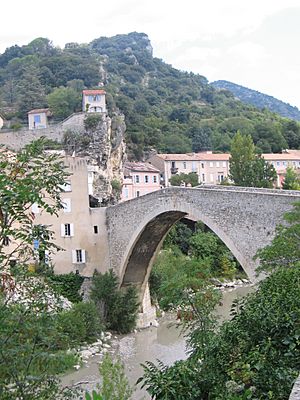Tanche facts for kids
Quick facts for kids Tanche |
|
|---|---|

Nyons, the place associated with Tanche olives
|
|
| Olive (Olea europaea) | |
| Color of the ripe fruit | Black |
| Also called | Olive de Nyons, Olive de Carpentras |
| Origin | France |
| Notable regions | Drôme, Vaucluse |
| Hazards | Spilocaea oleaginea, Verticillium dahliae, Bactrocera oleae |
| Use | Oil and table |
| Oil content | High |
| Fertility | Self-sterile |
| Growth form | Spreading |
| Leaf | Elliptic |
| Weight | 5–6 g |
| Shape | Spherical |
| Symmetry | Slightly asymmetrical |
The Tanche is a famous type of olive grown mostly in southern France. You can find it in the Drôme and Vaucluse areas. People often call it a perle noire, which means "the Black Pearl of Provence."
It's believed that the ancient Greeks brought the Tanche olive to France. This happened around the 4th century BC, in a city called Massilia (now Marseille).
Contents
Where Tanche Olives Grow
The Tanche olive grows mainly in the Drôme and northern Vaucluse regions of southern France. It's quite special because it doesn't usually grow well in other places. Farmers have tried to plant it elsewhere, but it rarely works out.
Different Names for Tanche Olives
Because this olive mostly grows in one area, it doesn't have many different names. In the town of Nyons and nearby, these olives are called "Olive de Nyons." This is the name most people around the world know them by. Another name, used in parts of Vaucluse, is "Olive de Carpentras."
What Tanche Olives Look Like
The Tanche olive tree is medium-sized and spreads out as it grows. Its leaves are shaped like an oval. The tree has a large, round top.
The olives themselves are quite big, weighing about 5 to 6 grams each. They are oval-shaped with a rounded tip. They are also a little bit uneven on one side. The pit inside is oval, rounded at both ends, and has a rough surface.
You can pick the olives when they are smaller in late November. If you want bigger olives, it's better to wait until December or January. When they are fully ripe, the olives turn a dark purple-black color.
How Tanche Olives Are Used
The Tanche olive is a "dual-use" type, meaning it's used for two main things. People eat them as table olives, and they are also used to make olive oil. This olive tree produces a lot of fruit.
When pressed, Tanche olives give a good amount of oil, about 22% to 25% of their weight. The oil tastes smooth and has a fresh smell, like green apples and freshly cut grass. The oil is very sweet if the olives are picked late in the season. Olives picked later also give the oil more flavor.
The Tanche olive is the only one to have a special label called appellation of Nyons. This label means the oil comes from a specific place and meets high quality rules. It was given this special status in 1994. To get this label, the oil must be at least 95% Tanche olives. Tanche olives are also popular for making tapenade, a tasty spread.
How Tanche Olives Grow and Produce
The Tanche olive tree takes a while to start producing olives. But once it does, it produces a lot! This type of olive needs another tree to help it make fruit. This is because it's "self-sterile," meaning it can't fertilize itself. The most common tree used to help is called the Cayon olive tree.
Today, there are over 230,000 Tanche olive trees. Each year, they produce about 400 tons of olives for eating and 200 tons of olive oil.
Tanche trees can be affected by certain pests. These include a fungus called Spilocaea oleaginea, another disease called Verticillium dahliae, and the Bactrocera oleae. Besides pests, strong wind is a big danger to these trees. However, they are quite good at handling cold weather.


